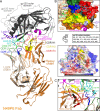Near-Pan-neutralizing, Plasma Deconvoluted Antibody N49P6 Mimics Host Receptor CD4 in Its Quaternary Interactions with the HIV-1 Envelope Trimer
- PMID: 34281393
- PMCID: PMC8406290
- DOI: 10.1128/mBio.01274-21
Near-Pan-neutralizing, Plasma Deconvoluted Antibody N49P6 Mimics Host Receptor CD4 in Its Quaternary Interactions with the HIV-1 Envelope Trimer
Abstract
The first step in HIV-1 entry is the attachment of the envelope (Env) trimer to target cell CD4. As such, the CD4-binding site (CD4bs) remains one of the few universally accessible sites for antibodies (Abs). We recently described a method of isolating Abs directly from the circulating plasma and described a panel of broadly neutralizing Abs (bnAbs) from an HIV-1 "elite neutralizer" referred to as patient N49 (N49 Ab lineage [M. M. Sajadi, A. Dashti, Z. R. Tehrani, W. D. Tolbert, et al., Cell 173:1783-1795.e14, 2018, https://doi.org/10.1016/j.cell.2018.03.061]). Here, we describe the molecular details of antigen recognition by N49P6, an Ab of the N49 lineage that recapitulates most of the neutralization breadth and potency of the donor's plasma IgG. Our studies done in the context of monomeric and trimeric antigens indicate that N49P6 combines many characteristics of known CD4bs-specific bnAbs with features that are unique to the N49 Ab lineage to achieve its remarkable neutralization breadth. These include the omission of the CD4 Phe43 cavity and dependence instead on interactions with highly conserved gp120 inner domain layer 3. Interestingly, when bound to BG505 SOSIP, N49P6 closely mimics the initial contact of host receptor CD4 to the adjacent promoter of the HIV-1 Env trimer to lock the trimer in the closed conformation. Altogether, N49P6 defines a new class of near-pan-neutralizing, plasma deconvoluted CD4bs Abs that we refer to as the N49P series. The details of the mechanisms of action of this new Ab class pave the way for the next generation of HIV-1 bnAbs that can be used as vaccine components of therapeutics. IMPORTANCE Binding to target cell CD4 is the first crucial step required for HIV-1 infection. Thus, the CD4-binding site (CD4bs) is one of the most accessible sites for antibodies (Abs). However, due to steric constraints, only a few Abs are capable of targeting this site. Here, we show that the exceptional neutralization breadth and potency of N49P6, a near-pan-neutralizing Ab targeting the CD4bs isolated from the plasma of an HIV-1 "elite neutralizer," patient N49, are due to its signature combination of more typical CD4bs Ab-binding characteristics with unique interactions with the highly conserved gp120 inner domain. In addition, we also present a structural analysis of N49P6 in complex with the BG505 SOSIP trimer to show that N49P6 exhibits remarkable breadth in part by mimicking CD4's quaternary interaction with the neighboring gp120 protomer. In its mode of antigen interaction, N49P6 is unique and represents a new class of CD4bs-specific bnAbs.
Keywords: CD4-binding site; HIV; N49P lineage; near-pan-neutralizing; neutralizing antibodies.
Figures







References
-
- Wu X, Yang ZY, Li Y, Hogerkorp CM, Schief WR, Seaman MS, Zhou T, Schmidt SD, Wu L, Xu L, Longo NS, McKee K, O’Dell S, Louder MK, Wycuff DL, Feng Y, Nason M, Doria-Rose N, Connors M, Kwong PD, Roederer M, Wyatt RT, Nabel GJ, Mascola JR. 2010. Rational design of envelope identifies broadly neutralizing human monoclonal antibodies to HIV-1. Science 329:856–861. doi:10.1126/science.1187659. - DOI - PMC - PubMed
-
- Trkola A, Pomales AB, Yuan H, Korber B, Maddon PJ, Allaway GP, Katinger H, Barbas CF, III, Burton DR, Ho DD, Moore JP. 1995. Cross-clade neutralization of primary isolates of human immunodeficiency virus type 1 by human monoclonal antibodies and tetrameric CD4-IgG. J Virol 69:6609–6617. doi:10.1128/JVI.69.11.6609-6617.1995. - DOI - PMC - PubMed
-
- Gray ES, Madiga MC, Moore PL, Mlisana K, Abdool Karim SS, Binley JM, Shaw GM, Mascola JR, Morris L. 2009. Broad neutralization of human immunodeficiency virus type 1 mediated by plasma antibodies against the gp41 membrane proximal external region. J Virol 83:11265–11274. doi:10.1128/JVI.01359-09. - DOI - PMC - PubMed
-
- Huang J, Kang BH, Pancera M, Lee JH, Tong T, Feng Y, Imamichi H, Georgiev IS, Chuang GY, Druz A, Doria-Rose NA, Laub L, Sliepen K, van Gils MJ, de la Pena AT, Derking R, Klasse PJ, Migueles SA, Bailer RT, Alam M, Pugach P, Haynes BF, Wyatt RT, Sanders RW, Binley JM, Ward AB, Mascola JR, Kwong PD, Connors M. 2014. Broad and potent HIV-1 neutralization by a human antibody that binds the gp41-gp120 interface. Nature 515:138–142. doi:10.1038/nature13601. - DOI - PMC - PubMed
Publication types
MeSH terms
Substances
Grants and funding
LinkOut - more resources
Full Text Sources
Research Materials
